
Dressuur-rijkunst-discussie-foto-film-beoordeling
Moderators: Essie73, Coby, balance, Firelight, Dyonne, NadjaNadja, Neonlight, Sica, C_arola
- oji
-

- Berichten: 4995
- Geregistreerd: 29-07-09
Re: Dressuur-rijkunst-discussie-foto-film-beoordeling

- Horseware
- Berichten: 5440
- Geregistreerd: 06-08-09
vur schreef:De tijd nemen is altijd goed. Bij een jong paard (3 a 4 jarige) duurt het nog wel langer dan 1,5 jaar om echt goede verzameling te kunnen rijden. Dus wat dat betreft is 1,5 wel weer kort. Maar voor een gereden paard leek mij 1,5 gewoon erg veel.
Will Faerber geeft daarbij aan dat dat is uitgaande van een paard dat nog nooit correct over de rug getraind is. Hierbij zou het niet uitmaken of je paard 4 of 24 is; de correcte spieropbouw duurt ongeveer 2 jaar. Is je paard wel correct getraind dan is het natuurlijk korter want dan heb je al deels de juiste bespiering.
- Tancreda4
-

- Berichten: 26141
- Geregistreerd: 12-01-03
- Woonplaats: ZuidHolland
Ben dan ook jaloers op filmpjes als Horseware. Ik kan daar alleen maar van dromen bij mijn merrie
 Denk niet dat we daar ooit zullen raken omdat er altijd wel wat tussen de oren zit, alles in de gaten houden, alles stressen. De uitspraken van; normaal zou hij wegrennen, met deze manier van rijden blijft hij rustig bij mij, wil ik het wel proberen, elke kleine stap is er eentje toch
Denk niet dat we daar ooit zullen raken omdat er altijd wel wat tussen de oren zit, alles in de gaten houden, alles stressen. De uitspraken van; normaal zou hij wegrennen, met deze manier van rijden blijft hij rustig bij mij, wil ik het wel proberen, elke kleine stap is er eentje toch  Vandaag met longeren ging ze best fijn zakken, maar voor haar is zakken echt heel lastig. Ik moet haar eerst echt recht maken, en dan toch wat meer oppakken, voor ze mijn hand kan gaan volgen. En die achterhand dan actief houden is helemaal moeilijk. Leuk zo'n tuiger met een mooi plat kruis waarbij de achterhand erbij houden heel moeilijk is ook
Vandaag met longeren ging ze best fijn zakken, maar voor haar is zakken echt heel lastig. Ik moet haar eerst echt recht maken, en dan toch wat meer oppakken, voor ze mijn hand kan gaan volgen. En die achterhand dan actief houden is helemaal moeilijk. Leuk zo'n tuiger met een mooi plat kruis waarbij de achterhand erbij houden heel moeilijk is ook 
- Starbreeze
-

- Berichten: 4581
- Geregistreerd: 16-08-03
Nu met een super passend maatzadel (daar zijn veel problemen ook mee opgelost) en onze nieuwe manier van rijden is het in zo'n korte tijd al een wereld van verschil. Eigenlijk is het super simpel dat paardrijden
 en leuk
en leuk  Versie 2.0 van mijn paard
Versie 2.0 van mijn paard 
- Horseware
- Berichten: 5440
- Geregistreerd: 06-08-09
- Starbreeze
-

- Berichten: 4581
- Geregistreerd: 16-08-03
 niet gelijk aan het begin van de training natuurlijk maar als we al wat gedraafd en gegaloppeerd hebben, blijft hij in de stretch en maakt het niet zoveel meer uit
niet gelijk aan het begin van de training natuurlijk maar als we al wat gedraafd en gegaloppeerd hebben, blijft hij in de stretch en maakt het niet zoveel meer uit  Hij loopt nog niet zo constant vanaf het begin helemaal in de stretch als jouw paard. Maar als we dus wat opgewarmd zijn lukt het wel.
Hij loopt nog niet zo constant vanaf het begin helemaal in de stretch als jouw paard. Maar als we dus wat opgewarmd zijn lukt het wel. Goed om te weten dus!
Laatst bijgewerkt door Starbreeze op 18-07-15 20:00, in het totaal 1 keer bewerkt
- smurvaas
-

- Berichten: 455
- Geregistreerd: 12-04-09
- Woonplaats: Ergens in een klein dorpje in Zuid Holland
xxdomiixx schreef:Ziet er goed uit. Knap dat hij zakt op stemcommando, hoe heb je dat gedaan? En is er een reden voor dat de longeerlijn grotendeels over de grond sleept?
Ja, klinkt een beetje vaag, maar in mn hoofd een plaatje nemen waar ik m wil hebben, vragen te zakken en braaaaf roepen als hij t doet.
Longeerlijn sleept zo laag omdat ik zelf nog ff moet zoeken hoe ik m moet houden en m dan niet wil storen door weer een ruk te geven aan de lijn.
- xxdomiixx
-

- Berichten: 1495
- Geregistreerd: 21-11-12
- Woonplaats: Harderwijk
smurvaas schreef:xxdomiixx schreef:Ziet er goed uit. Knap dat hij zakt op stemcommando, hoe heb je dat gedaan? En is er een reden voor dat de longeerlijn grotendeels over de grond sleept?
Ja, klinkt een beetje vaag, maar in mn hoofd een plaatje nemen waar ik m wil hebben, vragen te zakken en braaaaf roepen als hij t doet.
Longeerlijn sleept zo laag omdat ik zelf nog ff moet zoeken hoe ik m moet houden en m dan niet wil storen door weer een ruk te geven aan de lijn.
Ga ik ook eens proberen
 aah oke, dat probleem had ik ook
aah oke, dat probleem had ik ook  na 3x is het bij mij al iets beter geworden en minder gerommel haha.
na 3x is het bij mij al iets beter geworden en minder gerommel haha. - Muronia
-

- Berichten: 22065
- Geregistreerd: 29-04-09
- Woonplaats: Aan het kanaal, achter de spoordijk
 . Ik plaatste ze trouwens niet omdat er een probleem is, we zijn gewoon lekker aan het werk, even voor de duidelijkheid.
. Ik plaatste ze trouwens niet omdat er een probleem is, we zijn gewoon lekker aan het werk, even voor de duidelijkheid. Paardje heeft een veulen van 3 maanden oud aan de voet en deze heeft nogal wat van haar gevergd qua vetjes en bespiering, dus we bouwen weer rustig aan op. Ik wil even verduidelijken dat ik haar dus niet constant bovenin zet, maar dit zijn de momenten na de warming up waarin ik veel aan het schakelen ben in de tempi en haar meer activeer. Ze loopt van zich uit makkelijk laag, maar door haar neerwaartse bouw wissel ik ook af naar een hogere houding.
De aanleuning die ik heb is licht en constant, zowel hoog als laag, daarover heb ik helemaal niks te klagen. Af en toe neem ik stukjes halsstrekken mee, het duurt eventjes voordat de neus er wat meer uitkomt, maar dat gebeurt uiteindelijk wel.
Ik plaats hierbij nog enkele foto's van dezelfde training, maar dan meer in de warming-up fase.
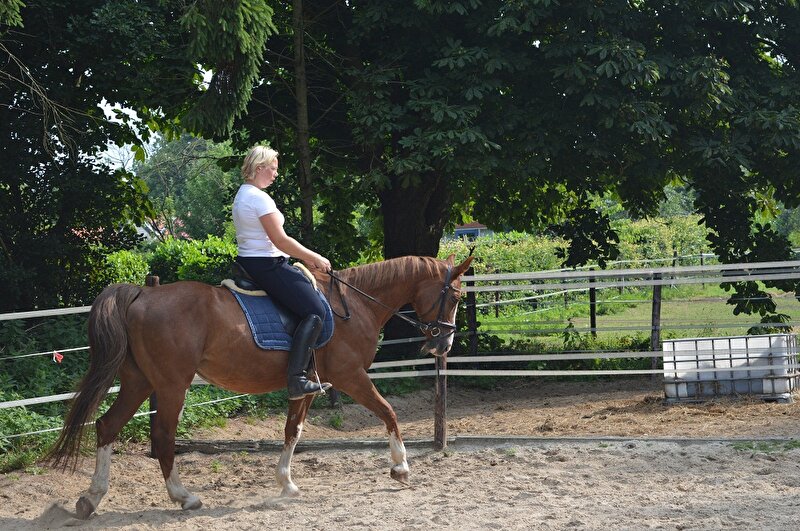
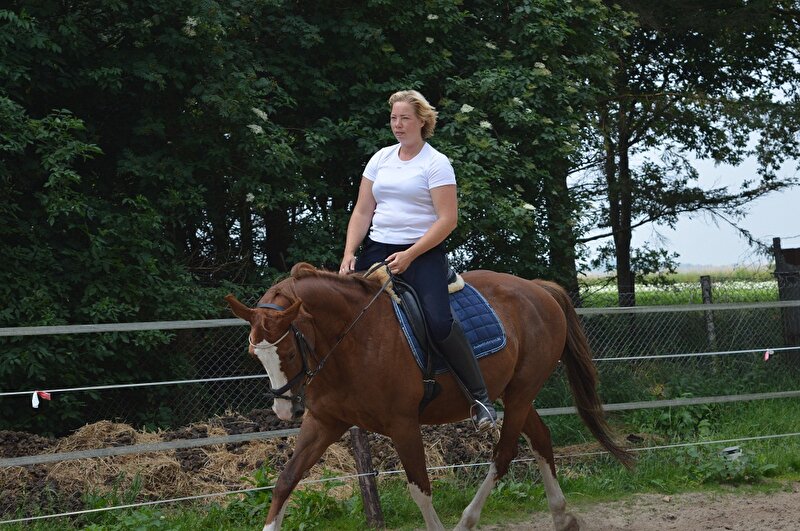
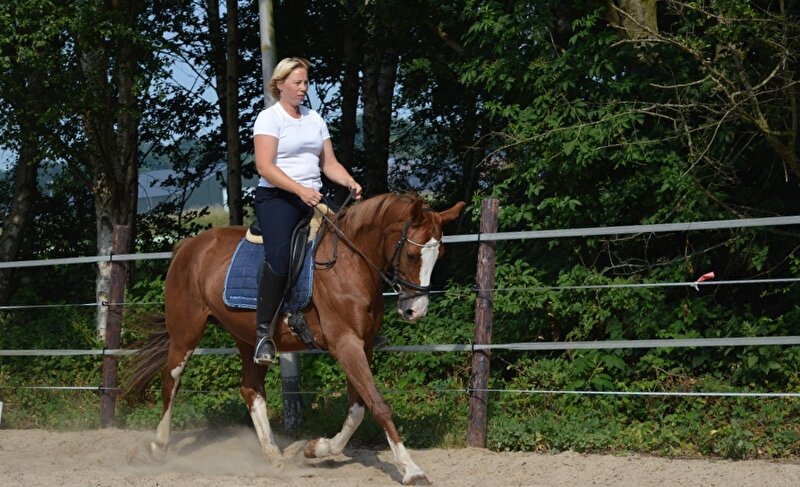
- Woestein
-

- Berichten: 2852
- Geregistreerd: 09-12-01
Zo om maar even met de deur in huis te vallen..
Heb iemand gevonden die even een stukje wilde filmen...
Voor mijn gevoel zakte hij meer naar beneden (lees als hij zijn hoofd omlaag doet zie ik alleen nog maar een stukje hals bij zijn schoft) maar hij gaat dus niet zo laag...
Hoop dat het filmpje het doet, geplaatst met mijn mobiel.
(Edit foto's bij geplaatst)
Het elastiekje!
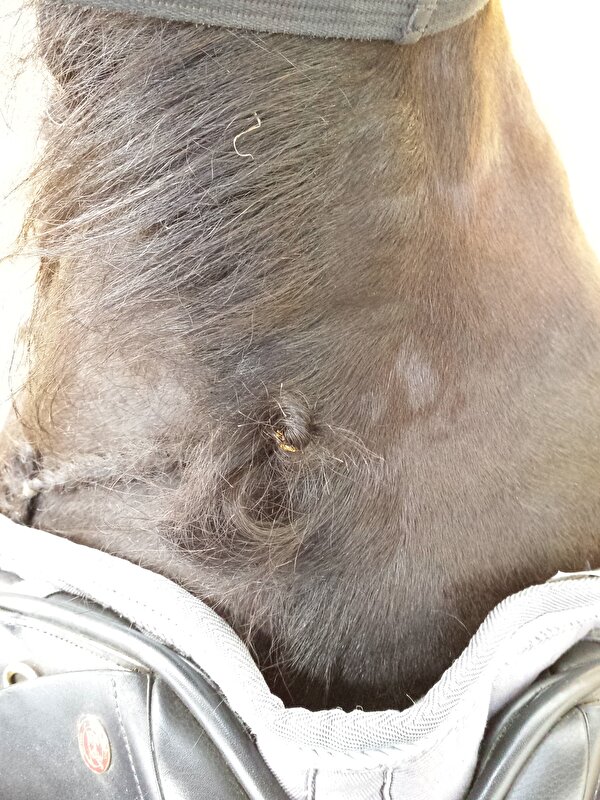
Was wel even lastig om tijdens het strekken een foto te maken zonder hem te storen...
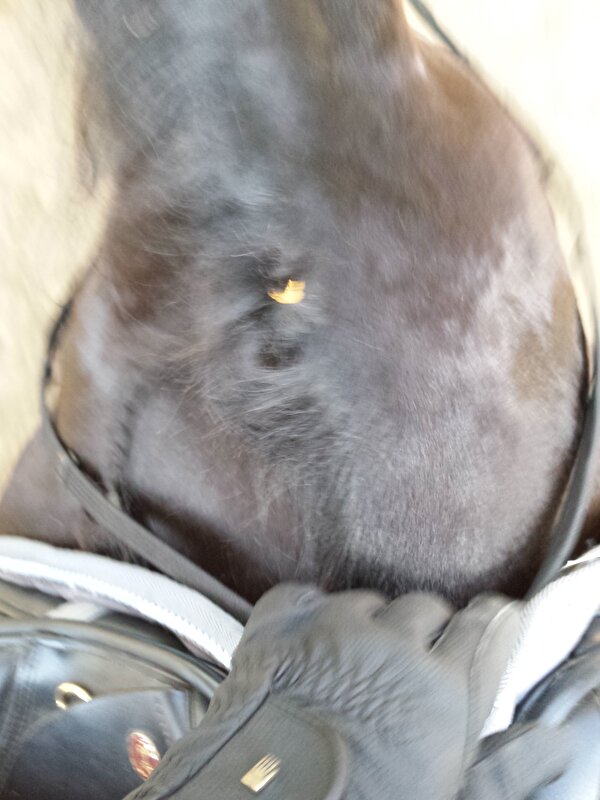
- Remember
-

- Berichten: 6005
- Geregistreerd: 13-06-03

Remember schreef:[***] schreef:Jij gaat door voor de koelkast
De buispieren hebben al een vrij zware taak, namelijk de enorme ingewanden van het paard op z'n plaats houden. De buikspieren zijn allemaal vrij dunne lapjes, waar heel veel bindweefsel in zit. Aan de anatomie te zien, is het dus helemaal niet logisch dat de buikspieren zo'n prominente rol innemen in de beweging.
Twee verschillende theorieën uitgelegd in plaatjes:
[ [url=m/5KUqoQ.jpg]Afbeelding[/url] ]
[ [url=m/jQlzAV.jpg]Afbeelding[/url] ]
Interessant leesvoer, naast deze artikelen is er nog wel meer te vinden;
http://horsetalk.co.nz/2013/01/16/bent- ... z3dUNYTai1
http://horsetalk.co.nz/2013/02/26/stret ... z3dUNYTai1
http://horsetalk.co.nz/2013/09/04/stret ... z3dUNYTai1
http://horsetalk.co.nz/2013/09/04/stret ... z3dUNYTai1
Uit 1 van bovenstaande artikelen;Citaat:The question might be; but why then does the horse lower the neck spontaneously after work? The response is simple. The horse eases the work of the upper neck muscles using the elastic resistance of the nuchal ligament. The nuchal ligament is inserted on the dorsal spines of the first through fourth thoracic vertebrae. At the other end, the funicular element of the nuchal ligament is attached on the skull. The nuchal ligament is not under tension when the neck is held in an alert position but does, in fact, come under tension when the horse lowers the neck.
The nuchal ligament, which can be compared to a strong bungee cord, elongates assisting the upper neck muscles in their task of supporting the head and neck. The nuchal ligament replaces 55% or more of the work of the upper neck muscles at the walk.
At the trot and canter, the assistance of the nuchal ligament replaces between 32 to 34% of the work of the upper neck muscles. As the horse lowers the neck, the tension of the nuchal ligament increases and the work of the upper neck muscles decreases.
This is not stretching; this is simply easing the work of the upper neck muscles.
The thought that the lowering of the neck increases the range of motion of the horse’s thoracolumbar spine is also inaccurate. Measurements have been made recording loss and gains in vertebral mobility when the neck is lowered.
The experiment involved five specimens. All the five specimens gained vertebral mobility between T6 and T9 when the neck was lowered. T6 and T9 is the front part of the withers. Such gain of mobility is mainly due to the fact that the supraspinous ligament, which is the continuation over the tip of the dorsal spines of the nuchal ligament, is still somewhat elastic until T9. One of the five specimens lost mobility between T9 and T14 when the neck was lowered. The other four specimens did not gain vertebral mobility in the same area, associated with the lowering of the neck. Another specimen lost vertebral mobility between T14 and T18 when the neck was lowered. The other specimens did not gain mobility in this specific area when the neck was lowered. All the specimens lost vertebral mobility in the lumbar vertebrae. The five specimens gained mobility in the lumbosacral junction. This is the reason why uneducated observations lead to the belief that the lumbar vertebrae flex when the neck is lowered
- SinneJ
-

- Berichten: 3083
- Geregistreerd: 02-04-15
- Woonplaats: België
Re: Dressuur-rijkunst-discussie-foto-film-beoordeling
- SinneJ
-

- Berichten: 3083
- Geregistreerd: 02-04-15
- Woonplaats: België
Re: Dressuur-rijkunst-discussie-foto-film-beoordeling
 ik leer er hopen uit...
ik leer er hopen uit... - Starbreeze
-

- Berichten: 4581
- Geregistreerd: 16-08-03
Re: Dressuur-rijkunst-discussie-foto-film-beoordeling
- Milkberry
- Berichten: 1174
- Geregistreerd: 12-02-15
- Woonplaats: Den Helder
Met deze foto als resultaat. Hij zakt nu tot dit niveau en blijft daar toch wel 2 rondjes bak.
Op mijn stal raken er steeds meer mensen geïnteresseerd in sure foot en stretchen. Leuk!
Beeldkwaliteit laat zwaar te wensen over. Moeders haar telefoon

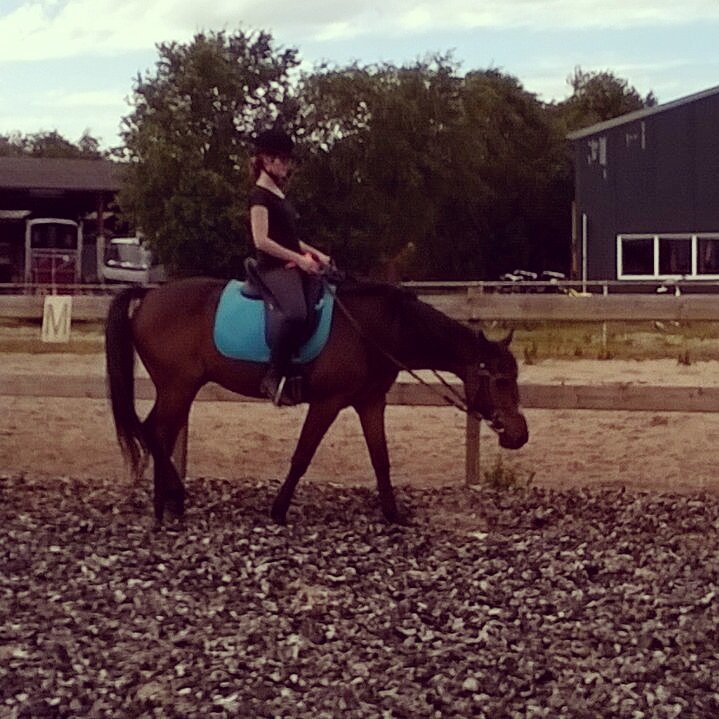
- sanne83
- Berichten: 5334
- Geregistreerd: 22-04-03
Remember schreef:Ik lees hier nog steeds wat mee en haal nog een keer een bericht naar boven, nav de laatste posts over welke houding natuurlijk is en wat het effect op het lichaam is. Het is wellicht geen 'makkelijk' leesvoer maar ik vond het erg interssant en zeker stof tot nadenken en in contrast met veel gemaakte aannames
Interessant leesvoer, naast deze artikelen is er nog wel meer te vinden;
http://horsetalk.co.nz/2013/01/16/bent- ... z3dUNYTai1
http://horsetalk.co.nz/2013/02/26/stret ... z3dUNYTai1
http://horsetalk.co.nz/2013/09/04/stret ... z3dUNYTai1
http://horsetalk.co.nz/2013/09/04/stret ... z3dUNYTai1
Bedankt voor de links! Interessant leesvoer inderdaad, ben het grotendeels eens. Iedereen zou dit moeten lezen! Ik moet dit allemaal eens gaan vertalen in het Nederlands
 Zeker qua anatomie. Soms ben ik het niet helemaal eens met zijn conclusies.
Zeker qua anatomie. Soms ben ik het niet helemaal eens met zijn conclusies.Alle anatomische verklaringen zijn zo ingesteld op het fysieke, dat vind ik altijd heel interessant.
Alsof door zus of zo te vragen, dat een soort van reflexmatige schakel geeft naar een ander effect in het lijf.
Alsof door het hoofd in een bepaalde houding te vragen, de rug dan automatisch een specifieke houding aanneemt. In deze artikelen komt mooi naar voren dat dat grotendeels gewoon niet zo zwart-wit is.
Als je bij jezelf voelt, je kan prima je hoofd in je nek leggen en daar een holle of een bolle bovenrug bij maken. Alleen je bovenste borstwervels willen graag meedoen met je nek.
Naar mijn mening hebben heel veel oefeningen grotendeels een effect op de MIND van het paard. Het hoofd naar beneden brengen bijvoorbeeld geeft een verhoging van endorphines, waardoor het paard zich meer ontspanning VOELT en daardoor ook de excessieve spanning in rug- en andere spieren zal loslaten. Wat er gebeurt is dus loslaten van overmatige spanning ipv stretchen, zodat de spieren weer gewoon soepel kunnen aanspannen en ontspannen en de beweging dus soepeler wordt.
Werken met lengtebuiging, wijkoefeningen, achterwaarts en specifieke patronen kunnen allemaal hetzelfde effect hebben op het paard. Als het paard zich ontspannen voelt, zal het zelf de hals strekken.
Daarom zie je soms ook mentaal ontspannen paarden die makkelijk de hals kunnen strekken, maar toch de schoft naar beneden drukken. Die paarden hebben een volledig verkeerd patroon van bewegen ontwikkeld. Vaak door een slecht passend zadel of een ruiter die in de weg zit. Of ooit ontstaan door zadel/ruiter die in de weg zit, of constante chronische stress in het verleden en nu zo ingesleten als een patroon dat de schoft daadwerkelijk niet meer omhoog kan komen, omdat alle spieren zich hebben aangepast aan die holle rug en dat nu pijn doet.
Ik neem even als voorbeeld het paard van Murosch. Wat ze beschijft is een paard die relaxed is en mentaal ontspannen, kan vwnw, ze heeft een lichte aanleuning, geen problemen etc. Toch houdt het paard op de foto heel duidelijk de schoft naar beneden gedrukt en het gebruikt niet de bovenste halsspieren om de basis van de hals te liften.Zoals je op dit plaatje kan zien.
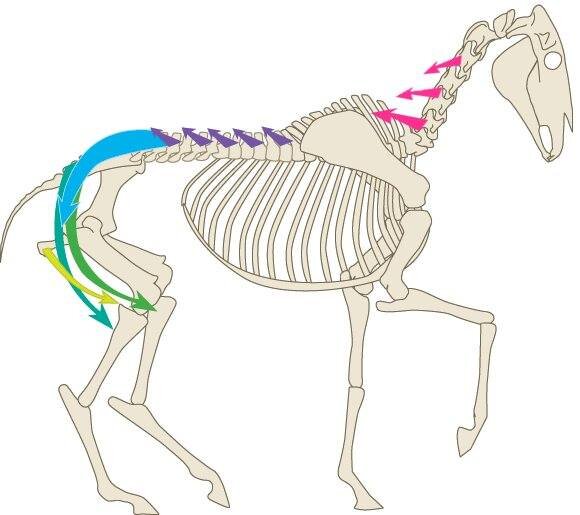
Bij dit paard heb je naar mijn idee specifieke technieken nodig die in de arbeidshouding dit paard kunnen helpen om te leren de schoft en basis van de hals te liften. Daarnaast natuurlijk zeker weten dat het zadel en de ruiter er niet voor zorgen dat het paard met de schoft naar beneden gedrukt loopt.
- Tuhan
-

- Berichten: 1592
- Geregistreerd: 06-10-03
- Woonplaats: Almere
vur schreef:Ik dacht dat er Z-ruiters tussen zaten. Horseware is toch ook een Z-ruiter? En ik heb best geduld om even te wachten hoor.
Ik ben inderdaad ook een Z ruiter.
Gisteren weer gestart. Stretch gaat bij mij super en ik gebruik dit ook op het moment dat ik spanning voel opkomen. Ik doe mijn hand dan weer open en ze volgt meteen mijn hand.
Maar nu kreeg ik toch de kritiek dat ik mijn paard meer gesloten en bij elkaar moet rijden. Hier zit ik ontzettend mee te stoeien, want in de stretch voelt ze super fijn aan. Kreeg zelfs complimenten dat ze zo ontspannen is. Moeilijk moeilijk....
- Anoeska
-

- Berichten: 5899
- Geregistreerd: 01-01-03